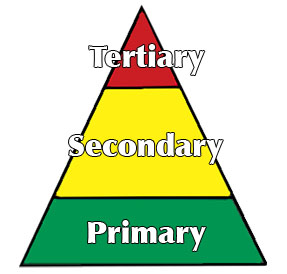 PBIS tiers addressed by alternatives found below:Tiers 2 & 3
PBIS tiers addressed by alternatives found below:Tiers 2 & 3
Alternatives to the Use of Seclusion and Restraint
I just finished reading a personally and professionally distressing article in the New York Times about the not-uncommon use of inappropriate restraint/seclusion with students who misbehave. It tells a heart-wrenching story (pasted below) with educators playing the roles of evil-doers. The heart-wrenching, angering piece moved me to respond. As educators, youth workers and child advocates, we must be above reproach. We must ascend beyond the medical profession's motto of "Primum non nocere" (First do no harm.) to "Facere solum bonum" (Do only good). That's wh y we went into teaching, right?
I've followed the article with a listing of interventions that can be implemented instead of the heinous and despicable acts that were perpetrated on children. The suggestions provide ethical, responsible, and effective alternatives for when aberrant behavior patterns in kids place frustrated teachers and administrators at risk for having their professional heads fall off their shoulders.
 PBIS tiers addressed by alternatives found below:Tiers 2 & 3
PBIS tiers addressed by alternatives found below:Tiers 2 & 3
_____________________________________________
THE ARTICLE
(Dr. Mac’s suggestions for avoidance are found below the publication)
Source: New York Times
OPINION
A Terrifying Way to Discipline Children

By BILL LICHTENSTEIN
Published: Sunday, Sept. 09, 2012
In my public school 40 years ago, teachers didn't lay their hands on students for bad behavior. They sent them to the principal's office. But in today's often overcrowded and underfunded schools, where one in eight students receive help for special learning needs, the use of physical restraints and seclusion rooms has become a common way to maintain order.
It's a dangerous development, as I know from my daughter's experience. At the age of 5, she was kept in a seclusion room for up to an hour at a time over the course of three months, until we discovered what was happening. The trauma was severe.
According to national Department of Education data, most of the nearly 40,000 students who were restrained or isolated in seclusion rooms during the 2009-10 school year had learning, behavioral, physical or developmental needs, even though students with those issues represented just 12 percent of the student population. African-American and Hispanic students were also disproportionately isolated or restrained.
Joseph Ryan, an expert on the use of restraints who teaches at Clemson University, told me that the practice of isolating and restraining problematic children originated in schools for children with special needs. It migrated to public schools in the 1970s as federal laws mainstreamed special education students, but without the necessary oversight or staff training. "It's a quick way to respond but it's not effective in changing behaviors," he said.
State laws on disciplining students vary widely, and there are no federal laws restricting these practices, although earlier this year Education Secretary Arne Duncan wrote, in a federal guide for schools, that there was "no evidence that using restraint or seclusion is effective." He recommended evidence-based behavioral interventions and de-escalation techniques instead.
The use of restraints and seclusion has become far more routine than it should be. "They're the last resort too often being used as the first resort," said Jessica Butler, a lawyer in Washington who has written about seclusion in public schools.
Among the recent instances that have attracted attention: Children in Middletown, Conn., told their parents that there was a "scream room" in their school where they could hear other children who had been locked away; last December, Sandra Baker of Harrodsburg, Ky., found her fourth-grade son, Christopher, who had misbehaved, stuffed inside a duffel bag, its drawstrings pulled tight, and left outside his classroom. He was "thrown in the hall like trash," she told me. And in April, Corey Foster, a 16-year-old with learning disabilities, died on a school basketball court in Yonkers, N.Y., as four staff members restrained him following a confrontation during a game. The medical examiner ruled early last month that the death was from cardiac arrest resulting from the student's having an enlarged heart, and no charges were filed.
I saw firsthand the impact of these practices six years ago when my daughter, Rose, started kindergarten in Lexington, Mass. Rose had speech and language delays. Although she sometimes became overwhelmed more quickly than other children, she was called "a model of age-appropriate behavior" by her preschool. One evaluation said Rose was "happy, loves school, is social." She could, however, "get fidgety and restless when she is unsure as to what is expected of her. When comfortable, Rose is a very participatory and appropriate class member with a great deal to contribute to her world."
Once in kindergarten, Rose began throwing violent tantrums at home. She repeatedly watched a scene from the film "Finding Nemo" in which a shark batters its way into a tiny room, attempting to eat the main characters. The school provided no explanation or solution. Finally, on Jan. 6, 2006, a school aide called saying that Rose had taken off her clothes. We needed to come get her.
At school, her mother and I found Rose standing alone on the cement floor of a basement mop closet, illuminated by a single light bulb. There was nothing in the closet for a child - no chair, no books, no crayons, nothing but our daughter standing naked in a pool of urine, looking frightened as she tried to cover herself with her hands. On the floor lay her favorite purple-striped Hanna Andersson outfit and panties.
Rose got dressed and we removed her from the school. We later learned that Rose had been locked in the closet five times that morning. She said that during the last confinement, she needed to use the restroom but didn't want to wet her outfit. So she disrobed. Rather than help her, the school called us and then covered the narrow door's small window with a file folder, on which someone had written "Don't touch!"
We were told that Rose had been in the closet almost daily for three months, for up to an hour at a time. At first, it was for behavior issues, but later for not following directions. Once in the closet, Rose would pound on the door, or scream for help, staff members said, and once her hand was slammed in the doorjamb while being locked inside.
At the time, I notified the Lexington Public Schools, the Massachusetts Department of Children and Families and the Department of Mental Health about Rose and other children in her class whom school staff members indicated had been secluded. If any of these agencies conducted a formal investigation, I was not made aware of it.
Rose still has nightmares and other symptoms of severe stress. We brought an action against the Lexington Public Schools, which we settled when the school system agreed to pay for the treatment Rose needed to recover from this trauma.
The physical and psychological injuries to children as a consequence of this disciplinary system is an issue that has found its way to Congress. Legislation to ban these practices has been introduced in the House and the Senate, but no vote is expected this year.
Meanwhile, Rose is back in public school and has found it within her to forgive those involved in her case. "They weren't bad people," she told me. "They just didn't know about working with children.
End of Article
WHAT ELSE COULD THEY HAVE DONE? LOTS!!!
There is so much that can be done in these situations besides implementing “zero tolerance” policies and “teaching the kid a lesson” via harsh punishments. Zero tolerance (except in the case of weapons) equals zero thinking. It is the default response for educators who have run out of ideas. I have zero tolerance for zero tolerance educators. (Oops… did I just drop my brain?) In the spirit of helping our misguided colleagues make their own professional lives better while adhering to their mission to reach and teach kids, check out the ideas found below. “Teaching that kid a lesson” never does so… at least no t the lesson that we would like to have the child learn. "Facere solum bonum".
.
Here is a smattering of suggestions for responding to persistent misbehavior on the part of our junior citizens... ways in which we can be proud of our actions, not defensive of them:
1. Conduct a “Functional Behavior Assessment” in order to determine the function/cause/reason for the repeated behavior. Dip below the surface behavior with other analyses. Then meet as a team to devise productive ways to address the behavior pattern.
2. Become familiar with the Conflict Cycle in order to avoid it and escape it. (Dr. Mac will be uploading video podcasts on this model when the new site is opened)
3. Become familiar with PBIS (Positive Behavior Intervention Strategies)
4. Become proficient in EFFECTIVE praise and criticism that helps build appropriate behaviour, not incite inappropriate actions.
5. Use positivity instead of punishment. Research shows that punishment DOES NOT teach new behaviors. Want to change behavior for the better and FAST? Utilize one of the most powerful behaviour change procedures known: Differential Reinforcement.
6. If a youngster is not showing a desired behavior, TEACH IT! Behavior is taught just like academics. Create your unit and implement the lessons. Behaviors can be taught with powerful positive change practices like:
7. For youngsters who are highly resistant to the usual interventions, move them closer to being prepared and willing to change with:
a. The Circle of Courage model (scroll down to C of C) & C of C assessment materials
b. The Readiness for Change assessment and remediation model
8. Call in an expert. If the behavior consultant in your district has no ideas, bring in a bigger brain. Back-in-the-day, I was summoned by a special school for learners with severe behavior disorders. They had been using locked “time out” rooms until the local fire department told them that the practice violated fire code. If a blaze broke out and the monitor ran away or was overcome by smoke, the child would be trapped inside that enclosure. "Plan B"?... They hired BIG guys to lean against the door to the room that was being shouldered by the youth inside. Solution? Call me.
9. There is so much more that might apply in a particular situation: Counseling, cognitive behavior therapy (for faculty and student), bibliotherapy, self-monitoring, a “shadow" paraprofessional (one with strong training in positive and effective behavior management/change strategies, not somebody hired off the street yesterday), etc.
10. Know your district's policies on restraint, seclusion, and "time out". Be familiar with effective time out practices and procedures.
11. When teachers or administrators suggest placing a pupil in a closet, tell them to look at the big bug on the ceiling... and then shove them into darkness and latch the door behind them. NO. NO. Just kidding. TEACH THEM better ways.
.
..
.
Kids’ minds are fragile. Let’s be careful out there!
.
.
![]()
| Fetch Dr. Mac's Home Page |
Author: Tom McIntyre (Dr. Mac) at www.BehaviorAdvisor.com
The material found below was originally sent in an e-mail to the BehaviorAdvisor.com "B-List".
.
.
.